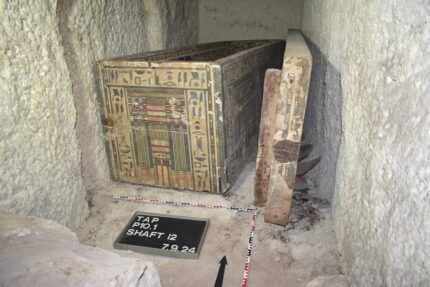A 6th-century female burial chamber discovered near the town of Kölleda in Thuringia will be unveiled to the public on November 9. Part of the chamber is still encased in a huge earthen mass.
The tomb was discovered during archaeological excavations on a 20-hectare site to be built. Between 2017 and 2021, the Office for the Conservation and Archeology of Thuringia’s National Monuments (TLDA) unearthed more than 3,700 archaeological artifacts from the region’s 4,000 years of settlement history. Of particular note are the 17 tombs dating from the 6th and 7th centuries, the transitional period when the Kingdom of Thuringia collapsed in 531 and became part of the Merovingian Frankish Empire.
Excavations also uncovered a settlement from the same period 330 feet south of the cemetery. The remains of about 70 houses were unearthed. It is one of the very few Merovingian villages discovered in central Germany and the only one that has been archaeologically excavated and has an associated cemetery.
This cemetery is unusual in many ways. Eleven beheaded horses were buried in seven pits next to the dead. The tombs were also atypical: they were dug extremely deep and contained elaborate wooden burial chambers with grave goods including weapons, jewelry, glassware from the Rhine-Main region, and bronze vessels made in the eastern Mediterranean. These bronze vessels are extremely rare and have only been found in the tombs of nobles in Frankish territory.
 One of the tombs stood out from the other 16 because it was buried 13 feet below the soil surface and had a second burial chamber built above it, lined with large stones along the edges. The presence of the second burial chamber prevented theft of the tombs beneath it. The depth of the tomb and the second chamber also prevented this significant tomb from being destroyed when bombs exploded during World War II.
One of the tombs stood out from the other 16 because it was buried 13 feet below the soil surface and had a second burial chamber built above it, lined with large stones along the edges. The presence of the second burial chamber prevented theft of the tombs beneath it. The depth of the tomb and the second chamber also prevented this significant tomb from being destroyed when bombs exploded during World War II.
The entire burial chamber and surrounding soil were removed to allow excavation to take place in TLDA’s workshop. The removed stones totaled 13 tons and were 15 feet deep. It must be wrapped in steel to be shipped. It has been at the TLDA Conservation Laboratory since March 2022, but excavation work was postponed until the end of 2023, when special equipment and new facilities made it possible to process such a large piece.
The various scanning methods used for the 3D recording of the various excavation stages ensured an optimal recording of the exact location of the objects in the grave pit. During excavation, skeletal material and other particularly fragile objects have been reinforced with impregnating agents. Next, the grave goods complex was divided into smaller pieces and examined using computed tomography and other analytical methods. In this way, for example, restorers can identify and specifically expose very small objects (such as a pearl necklace).
The grave that was examined belonged to a woman aged around 25-30 years old. Grave goods for the deceased include a variety of food and personal belongings. In particular, a large number of gold and silver jewelry and a carved bronze basin highlight the prominent social status of the deceased. These objects of outstanding artistic quality reveal the profound cultural ties that members of the upper classes had with regions as far away as central Italy and the Mediterranean.
The public is invited to visit the grave of Madame Kolleda at the TLDA restoration studio in Weimar on Saturday. Archaeologists will explain the complex excavations and their findings so far.


 Anal Beads
Anal Beads Anal Vibrators
Anal Vibrators Butt Plugs
Butt Plugs Prostate Massagers
Prostate Massagers
 Alien Dildos
Alien Dildos Realistic Dildos
Realistic Dildos
 Kegel Exercisers & Balls
Kegel Exercisers & Balls Classic Vibrating Eggs
Classic Vibrating Eggs Remote Vibrating Eggs
Remote Vibrating Eggs Vibrating Bullets
Vibrating Bullets
 Bullet Vibrators
Bullet Vibrators Classic Vibrators
Classic Vibrators Clitoral Vibrators
Clitoral Vibrators G-Spot Vibrators
G-Spot Vibrators Massage Wand Vibrators
Massage Wand Vibrators Rabbit Vibrators
Rabbit Vibrators Remote Vibrators
Remote Vibrators
 Pocket Stroker & Pussy Masturbators
Pocket Stroker & Pussy Masturbators Vibrating Masturbators
Vibrating Masturbators
 Cock Rings
Cock Rings Penis Pumps
Penis Pumps
 Wearable Vibrators
Wearable Vibrators Blindfolds, Masks & Gags
Blindfolds, Masks & Gags Bondage Kits
Bondage Kits Bondage Wear & Fetish Clothing
Bondage Wear & Fetish Clothing Restraints & Handcuffs
Restraints & Handcuffs Sex Swings
Sex Swings Ticklers, Paddles & Whips
Ticklers, Paddles & Whips







 The various scanning methods used for the 3D recording of the various excavation stages ensured an optimal recording of the exact location of the objects in the grave pit. During excavation, skeletal material and other particularly fragile objects have been reinforced with impregnating agents. Next, the grave goods complex was divided into smaller pieces and examined using computed tomography and other analytical methods. In this way, for example, restorers can identify and specifically expose very small objects (such as a pearl necklace).
The various scanning methods used for the 3D recording of the various excavation stages ensured an optimal recording of the exact location of the objects in the grave pit. During excavation, skeletal material and other particularly fragile objects have been reinforced with impregnating agents. Next, the grave goods complex was divided into smaller pieces and examined using computed tomography and other analytical methods. In this way, for example, restorers can identify and specifically expose very small objects (such as a pearl necklace).












